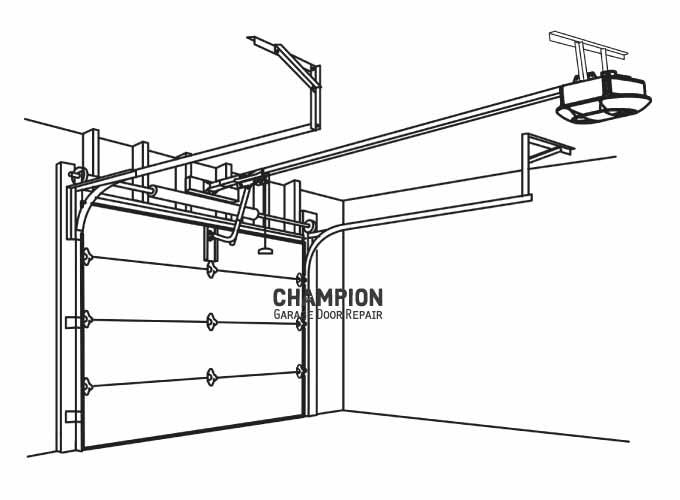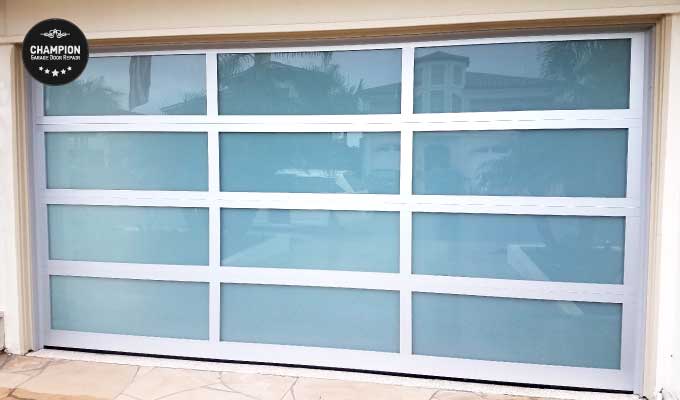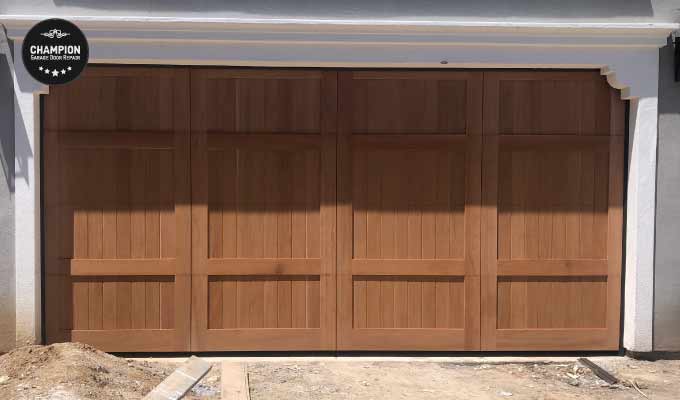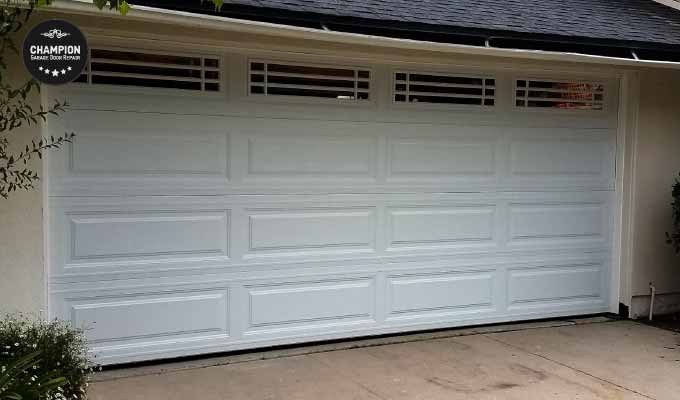A garage door is a large entryway usually positioned at the front of a garage, a structure intended for vehicle parking, storage, or commercial purposes. Its purpose is to facilitate convenient access for vehicles or items, enabling them to move in and out of the garage or structure with ease.
Garage doors are available in different types, such as sectional, single piece (tilt up), and roll-up, with various designs and materials including steel, aluminum, wood, and fiberglass. They can be operated manually or automatically using an electric door opener.
Sectional Garage Doors
A sectional garage door consists of multiple horizontal panels or sections, typically found in residential homes but also used in commercial settings.

These panels are connected by hinges and slide along tracks on each side of the garage opening, supported by rollers. Torsion or extension springs are used to counterbalance the door’s weight. Weather-stripping and insulation can be added to improve weatherproofing and energy efficiency.
Single Piece (Swing Up) Garage Doors
Single piece (swing up) garage doors are made from a single solid panel that swings up and out, resting parallel to the ceiling when fully open. Unlike sectional doors, they don’t have separate panels or tracks. They use a basic hinge mechanism and extension springs to counterbalance the door weight.

While their design is simple, they need space in front of the garage to function and may not be as efficient in terms of headroom since they can’t open beyond the garage opening.
Roll-Up Garage Doors
Roll-up garage doors are made of horizontal slats or panels that roll up and down along tracks installed vertically on the sides of the garage opening, eliminating the need for overhead tracks and hardware.

These slats are interconnected and often made of steel, aluminum, or fiberglass. Roll-up garage doors use torsion springs to counterbalance the door’s weight and are more popular in commercial and industrial settings.
Steel Garage Doors
The development and innovation in steel production marked a significant milestone for modern architecture. Modern steel production not only enabled greater architectural freedom and the emergence of new design opportunities but also made products like garage doors more affordable. Currently, there are several designs and variations of steel garage doors available on the market, including:
- Classic long panel (raised panel).
- Classic short panel (raised panel).
- Carriage house (raised).
- Stamped or flat carriage house (recessed).
- Wood overlay.
- Steel overlay.
- Fiberglass overlay.
- Contemporary flush.
- Contemporary planks.
Although steel garage doors are considered relatively lightweight and more vulnerable to dents, they offer great value, are relatively cheaper to maintain, and can be easily repainted if needed, as long as they don’t feature a smooth or wood-like finish.
Steel garage doors can also be painted to resemble wood. Achieving this wood-like appearance involves using pressing machines or digital imaging technology to create a realistic wood grain texture. Although garage doors painted to mimic wood are typically more expensive than those painted in standard colors, they offer the authentic look of wood without the maintenance requirements associated with real wood doors.
There are 4 kinds of steel garage doors:
- Single layer or hollow back (pan).
- 2-layer insulated or poly back.
- 3-layer insulated or steel back (sandwich).
- 4-layer with external overlay.
2-layer (or poly back) doors are insulated garage doors where the insulation material is exposed from the back. 3-layer or steel back garage doors have an additional layer that covers the insulation material from the back.
Sandwich-insulated garage doors can accommodate denser and heavier insulation material, making them more energy-efficient, durable, and offering better weatherproofing and soundproofing compared to hollow back or poly back garage doors.
4-layer garage doors are essentially 3-layer insulated doors with an additional external overlay layer. This layer is used for design purposes only, such as creating a carriage house appearance.
Advantages and Disadvantages of Steel Garage Doors
- Great variety and designs to choose from.
- Initial cost, repair, and maintenance are relatively low.
- Insulated garage doors offer good weatherproofing and soundproofing.
- In-stock and available parts and hardware.
- More prone to breakdowns and dents.
- Sensitive to corrosion and rust.
- Can be flimsy, more vulnerable to the elements and high winds.
Custom Wood Garage Doors
Custom wood garage doors can be made of various wood types such as African mahogany, oak, hemlock, and cedar. They offer flexible designs, including different trims, edges, windows, and panel layouts. Additionally, they can be finished in various ways, including smoothing, painting, or staining, to achieve a unique look.
The process of acquiring a wood garage door starts with the initial design phase, where the contractor or garage door repair company collaborates with the architect or customer to create a blueprint before proceeding to production.
Advantages and Disadvantages of Custom Wood Garage Doors
- Customizable and flexible design.
- Great weatherproofing and soundproofing.
- Resilient, durable when maintained correctly.
- High initial cost and expensive repairs.
- Labor intensive service and repair.
- High maintenance.
- Parts and hardware may need to be special ordered if replacement is needed.
Aluminum Full View Garage Doors
Aluminum (or full view) garage doors are constructed mainly from glass, with only the door’s frame made of aluminum, allowing an abundance of natural daylight to enter the structure.
The door frame can be powder-coated or anodized. Powder-coated aluminum frames are considered more eco-friendly, eliminating electrical conductivity and being more resilient to corrosion and the elements, although at a higher cost.

Different glass thicknesses available for aluminum garage doors include 1/8″, 1/4″, and 1/2″. Thicker glass provides better weatherproofing and soundproofing. The glass is secured in place with retainers made from aluminum and EPDM rubber strips, which not only secure the glass against the frame but also serve as an additional layer of sealant, minimizing glass vibration and increasing impact resistance. The glass can be tinted, tempered, or laminated for privacy purposes.
Aluminum garage doors are durable and resistant to corrosion, saltwater, and salty air. The alloy is also resistant to the effects of UV rays and can withstand extreme temperatures ranging from approximately -70 °C to +320 °C while maintaining its properties.
Advantages and Disadvantages of Aluminum Full View Garage Doors
- Contemporary and modern design.
- Exposure to natural light.
- Offer good weatherproofing and soundproofing, depending on the glass.
- Resilient and durable.
- Low maintenance.
- High initial cost and expensive repairs.
- Labor intensive service and repair.
- Parts and hardware may need to be special ordered if replacement is needed.
Carriage House Garage Doors
Since the arrival of modern architecture, the history of Western architecture has traversed various stylistic genres. Today, the designs of carriage house garage doors draw inspiration from the carriage houses of the 19th century. This era of architecture primarily sought to revive medieval decorative styles, including Gothic architecture, characterized by pointed and arched forms, and Greek architecture, known for its straight lines and symmetry.

Designers and architects of the 19th century referred to European medieval churches and Greek temples built between the 11th and 14th centuries. In the United States, these styles were initially used for church structures and later adapted for residential homes, barns, and carriage houses.
Advancements in tools and hardware facilitated the creation of decorative wood trim boards. This enabled the use of vertical and horizontal trim boards combined with diagonal ones, a common design characteristic in modern carriage house garage doors. While original carriage house doors were made of wood, modern versions can be made of steel, offering a look that reminds the vintage charm of 19th-century carriage houses.
Modern (Contemporary) Garage Doors
Modern garage doors break away from traditional styles, embracing new technologies, materials, and forms while prioritizing functionality and efficiency. They often feature large windows and minimalist designs, adhering to the principle of ‘less is more’ by using only necessary elements to achieve the desired function or aesthetic.

This contrasts with the design elements found in classic raised panel or carriage house garage doors. The goal of contemporary garage doors is to create an uncluttered, timeless look that promotes a sense of calm and well-being. Modern garage door styles include aluminum full view, flush panel, and plank designs.
Classic Raised and Recessed Panel Garage Doors
Raised panel refers to a design technique where parts of the garage door’s section are carved or constructed to protrude from the surrounding surface, creating a textured or dimensional effect. This technique has been used in architectural styles throughout history, particularly in traditional and classical designs. Raised panels are commonly found in architectural styles such as Georgian, Federal, and Colonial Revival, where they decorate doors, wainscoting, cabinetry, and exterior facades.

Raised panel garage doors often feature intricate detailing, adding a sense of elegance and sophistication to the overall door design. The stamping technique is used to create visual interest and add depth to what would otherwise be flat surfaces, enhancing the curb appeal and grandeur of both the garage door and the building itself. Classic raised panel garage doors come in various designs, including long or short panel configurations, and are typically constructed from steel or wood.
Similarly, recessed panel garage doors feature panels that are set back or indented into the surrounding surface instead of protruding from it, creating a sunken or recessed effect. Garage doors that feature recessed panels are often referred to as shaker or shaker flat.







